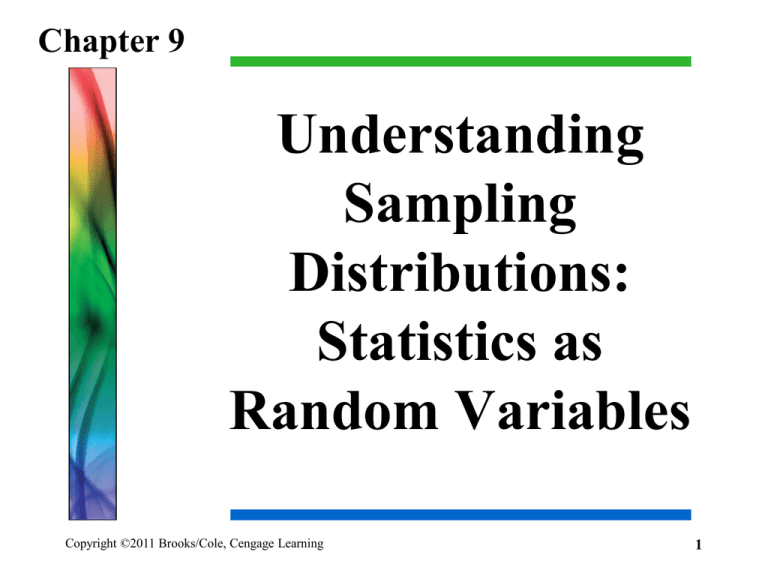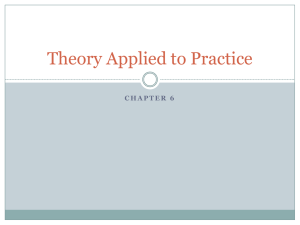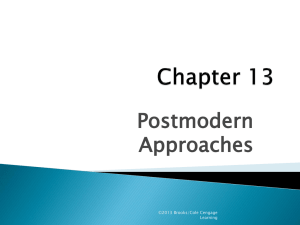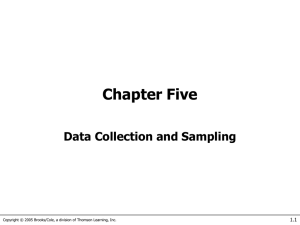Lecture Notes Chapter 9 - Department of Statistics and Probability
advertisement

Chapter 9 Understanding Sampling Distributions: Statistics as Random Variables Copyright ©2011 Brooks/Cole, Cengage Learning 1 CHAPTER EXPECTATIONS • SAMPLING DISTRIBUTION FOR ONE SAMPLE PROPORTION; • SAMPLING DISTRIBUTION FOR THE DIFFERENCE BETWEEN TWO SAMPLE PROPORTIONS; • SAMPLING DISTRIBUTION FOR ONE SAMPLE MEAN; • SAMPLING DISTRIBUTION FRO THE DIFFERENCE BETWEEN TWO SAMPLE MEANS; Copyright ©2011 Brooks/Cole, Cengage Learning 2 9.1 Parameters, Statistics, and Statistical Inference A statistic is a numerical value computed from a sample. Its value may differ for different samples. e.g. sample mean x , sample standard deviation s, and sample proportion pˆ. A parameter is a numerical value associated with a population. Considered fixed and unchanging. e.g. population mean m, population standard deviation s, and population proportion p. Copyright ©2011 Brooks/Cole, Cengage Learning 3 Statistical Inference Statistical Inference: making conclusions about population parameters on basis of sample statistics. Two most common procedures: Confidence intervals: an interval of values that the researcher is fairly sure will cover the true, unknown value of the population parameter. Hypothesis tests: uses sample data to attempt to reject a hypothesis about the population. Copyright ©2011 Brooks/Cole, Cengage Learning 4 9.2 From Curiosity to Questions about Parameters The Big Five Parameters Copyright ©2011 Brooks/Cole, Cengage Learning 5 Independent Samples Two samples are called independent samples when the measurements in one sample are not related to the measurements in the other sample. • Random samples taken separately from two populations and same response variable is recorded. • One random sample taken and a variable recorded, but units are categorized to form two populations. • Participants randomly assigned to one of two treatment conditions, and same response variable is recorded. Copyright ©2011 Brooks/Cole, Cengage Learning 6 Two Populations; Two Proportions Copyright ©2011 Brooks/Cole, Cengage Learning 7 Familiar Examples Translated into Questions about Parameters Situation 1. Estimating the proportion falling into a category of a categorical variable. Example research questions: What proportion of American adults believe there is extraterrestrial life? In what proportion of British marriages is the wife taller than her husband? Population parameter: p = proportion in the population falling into that category. Sample estimate: pˆ = proportion in the sample falling into that category. Copyright ©2011 Brooks/Cole, Cengage Learning 8 Familiar Examples Situation 2. Estimating the difference between two populations with regard to the proportion falling into a category of a qualitative variable. Example research questions: How much difference is there between the proportions that would quit smoking if taking the antidepressant buproprion (Zyban) versus if wearing a nicotine patch? How much difference is there between men who snore and men who don’t snore with regard to the proportion who have heart disease? Population parameter: p1 – p2 = difference between the two population proportions. Sample estimate: pˆ 1 pˆ 2 = difference between the two sample proportions. Copyright ©2011 Brooks/Cole, Cengage Learning 9 Familiar Examples Situation 3. Estimating the mean of a quantitative variable. Example research questions: What is the mean time that college students watch TV per day? What is the mean pulse rate of women? Population parameter: m = population mean for the variable Sample estimate: x = sample mean for the variable Copyright ©2011 Brooks/Cole, Cengage Learning 10 Familiar Examples Situation 5. Estimating the difference between two populations with regard to the mean of a quantitative variable. Example research questions: How much difference is there in average weight loss for those who diet compared to those who exercise to lose weight? How much difference is there between the mean foot lengths of men and women? Population parameter: m1 – m2 = difference between the two population means. Sample estimate: x1 x2 = difference between the two sample means. Copyright ©2011 Brooks/Cole, Cengage Learning 11 Sampling Distribution For One Sample Proportion PROBLEM FORMULATION: SUPPOSE THAT p IS AN UNKNOWN PROPORTION OF ELEMENTS OF A CERTAIN TYPE S IN A POPULATION. EXAMPLES • PROPORTION OF LEFT - HANDED PEOPLE; • PROPORTION OF HIGH SCHOOL STUDENTS WHO ARE FAILING A READING TEST; • PROPORTION OF VOTERS WHO WILL VOTE FOR MR. X. Copyright ©2011 Brooks/Cole, Cengage Learning 12 Estimation of p x ˆ p n Copyright ©2011 Brooks/Cole, Cengage Learning 13 9.3 Sampling Distribution For One Sample Proportion Statistics as Random Variables Each new sample taken value of the sample statistic will change. The distribution of possible values of a statistic for repeated samples of the same size from a population is called the sampling distribution of the statistic. Many statistics of interest have sampling distributions that are approximately normal distributions Copyright ©2011 Brooks/Cole, Cengage Learning 14 Illustration Copyright ©2011 Brooks/Cole, Cengage Learning 15 Example 9.2 Mean Hours of Sleep for College Students Survey of n = 190 college students. “How many hours of sleep did you get last night?” Sample mean = 7.1 hours. If we repeatedly took samples of 190 and each time computed the sample mean, the histogram of the resulting sample mean values would look like the histogram at the right: Copyright ©2011 Brooks/Cole, Cengage Learning 16 Standard Deviation and Standard Error of a Statistic • Standard deviation of a sampling distribution measures the variation among possible values of the sample statistic over all possible random samples. We include the name of the statistic being studied, e.g. the standard deviation of the mean. • Standard error describes the estimated value of the standard deviation of a statistic. We include the name of the statistic, e.g. the standard error of the mean. Copyright ©2011 Brooks/Cole, Cengage Learning 17 9.4 SD Mod 1: Sampling Distribution for One Sample Proportion • Suppose (unknown to us) 40% of a population carry the gene for a disease, (p = 0.40). • We will take a random sample of 25 people from this population and count X = number with gene. • Although we expect (on average) to find 10 people (40%) with the gene, we know the number will vary for different samples of n = 25. • In this case, X is a binomial random variable with n = 25 and p = 0.4. Copyright ©2011 Brooks/Cole, Cengage Learning 18 Many Possible Samples Four possible random samples of 25 people: Sample 1: X =12, proportion with gene =12/25 = 0.48 or 48%. Sample 2: X = 9, proportion with gene = 9/25 = 0.36 or 36%. Sample 3: X = 10, proportion with gene = 10/25 = 0.40 or 40%. Sample 4: X = 7, proportion with gene = 7/25 = 0.28 or 28%. Note: • Each sample gave a different answer, which did not always match the population value of 40%. • Although we cannot determine whether one sample will accurately reflect the population, statisticians have determined what to expect for most possible samples. Copyright ©2011 Brooks/Cole, Cengage Learning 19 Sampling Distribution for a Sample Proportion (The Central Limit Theorem) Let p = population proportion of interest or binomial probability of success. Let pˆ = sample proportion or proportion of successes. If numerous random samples or repetitions of the same size n are taken, the distribution of possible values of pˆ is approximately a normal curve distribution with • Mean = p p (1 p ) • Standard deviation = s.d.( pˆ ) = n This approximate distribution is sampling distribution of pˆ . Copyright ©2011 Brooks/Cole, Cengage Learning 20 ASSUMPTIONS AND CONDITIONS • ASSUMPTIONS • INDEPENDENCE ASSUMPTION: THE SAMPLED VALUES MUST BE INDEPENDENT OF EACH OTHER. • SAMPLE SIZE ASSUMPTION: THE SAMPLE SIZE, n, MUST BE LARGE ENOUGH • REMARK: ASSUMPTIONS ARE HARD – OFTEN IMPOSSIBLE TO CHECK. THAT’S WHY WE ASSUME THEM. GLADLY, SOME CONDITIONS MAY PROVIDE INFORMATION ABOUT THE ASSUMPTIONS. Copyright ©2011 Brooks/Cole, Cengage Learning 21 CONDITIONS • RANDOMIZATION CONDITION: THE DATA VALUES MUST BE SAMPLED RANDOMLY. IF POSSIBLE, USE SIMPLE RANDOM SAMPLING DESIGN TO SAMPLE THE POPULATION OF INTEREST. • 10% CONDITION: THE SAMPLE SIZE, n, MUST BE NO LARGER THAN 10% OF THE POPULATION OF INTEREST. • SUCCESS/FAILURE CONDITION: THE SAMPLE SIZE HAS TO BE BIG ENOUGH SO THAT WE EXPECT AT LEAST 10 SUCCESSES AND AT LEAST 10 FAILLURES. THAT IS, np 10 ( SUCCESS) nq 10 ( FAILLURE) Copyright ©2011 Brooks/Cole, Cengage Learning 22 The Normal Curve Approximation Rule for Sample Proportions Normal Approximation Rule can be applied in two situations: Situation 1: A random sample is taken from a population. Situation 2: A binomial experiment is repeated numerous times. In each situation, three conditions must be met: 1: The Physical Situation There is an actual population or repeatable situation. 2: Data Collection A random sample is obtained or situation repeated many times. 3: The Size of the Sample or Number of Trials The size of the sample or number of repetitions is relatively large, np and np(1-p) must be at least 5 and preferable at least 10. Copyright ©2011 Brooks/Cole, Cengage Learning 23 Examples for which Rule Applies • Election Polls: to estimate proportion who favor a candidate; units = all voters. • Television Ratings: to estimate proportion of households watching TV program; units = all households with TV. • Consumer Preferences: to estimate proportion of consumers who prefer new recipe compared with old; units = all consumers. • Testing ESP: to estimate probability a person can successfully guess which of 5 symbols on a hidden card; repeatable situation = a guess. Copyright ©2011 Brooks/Cole, Cengage Learning 24 Example 9.4 Possible Sample Proportions Favoring a Candidate Suppose 40% all voters favor Candidate C. Pollsters take a sample of n = 2400 voters. Rule states the sample proportion who favor X will have approximately a normal distribution with mean = p = 0.4 and s.d.( pˆ ) = p(1 p) n 0.4(1 0.4) 2400 0.01 Histogram at right shows sample proportions resulting from simulating this situation 400 times. Copyright ©2011 Brooks/Cole, Cengage Learning 25 Estimating the Population Proportion from a Single Sample Proportion In practice, we don’t know the true population proportion p, so we cannot compute the standard deviation of pˆ , s.d.( pˆ ) = p (1 p ) n . In practice, we only take one random sample, so we only have one sample proportion pˆ . Replacing p with pˆ in the standard deviation expression gives us an estimate that is called the standard error of pˆ . s.e.( pˆ ) = pˆ (1 pˆ ) n . If pˆ = 0.39 and n = 2400, then the standard error is 0.01. So the true proportion who support the candidate is almost surely between 0.39 – 3(0.01) = 0.36 and 0.39 + 3(0.01) = 0.42. Copyright ©2011 Brooks/Cole, Cengage Learning 26 EXAMPLE FROM MIDTERM III REVIEW SHEET • ASSUME THAT 30% OF STUDENTS AT A UNIVERSITY WEAR CONTACT LENSES ˆ • (A) WE RANDOMLY PICK 100 STUDENTS. LET p REPRESENT THE PROPORTION OF STUDENTS IN THIS SAMPLE WHO WEAR CONTACTS. WHAT’S THE APPROPRIATE MODEL FOR THE DISTRIBUTION OF pˆ ? SPECIFY THE NAME OF THE DISTRIBUTION, THE MEAN, AND THE STANDARD DEVIATION. BE SURE TO VERIFY THAT THE CONDITIONS ARE MET. • (B) WHAT’S THE APPROXIMATE PROBABILITY THAT MORE THAN ONE THIRD OF THIS SAMPLE WEAR CONTACTS? Copyright ©2011 Brooks/Cole, Cengage Learning 27 SOLUTION Copyright ©2011 Brooks/Cole, Cengage Learning 28 EXAMPLE FROM MIDTERM III REVIEW SHEET • INFORMATION ON A PACKET OF SEEDS CLAIMS THAT THE GERMINATION RATE IS 92%. WHAT’S THE PROBABILITY THAT MORE THAN 95% OF THE 160 SEEDS IN THE PACKET WILL GERMINATE? BE SURE TO DISCUSS YOUR ASSUMPTIONS AND CHECK THE CONDITIONS THAT SUPPORT YOUR MODEL. Copyright ©2011 Brooks/Cole, Cengage Learning 29 SOLUTION Copyright ©2011 Brooks/Cole, Cengage Learning 30 9.5 Sampling Distribution for Difference in Two Sample Proportions For the populations: p1 = population proportion for the first population. p2 = population proportion for the second population. Parameter: p1 – p2 = difference in popul proportions. For the samples: pˆ1 = sample proportion for sample from first popul. pˆ 2 = sample proportion for sample from second popul. Statistic: pˆ1 pˆ 2 = difference in sample proportions. Copyright ©2011 Brooks/Cole, Cengage Learning 31 Conditions Sampling distribution of difference in two independent sample proportions is approximately normal when: Condition 1: Sample proportions are available for two independent samples, randomly selected from the two populations of interest. Condition 2: All of the quantities n1p1, n1(1 – p1), n2p2, and n1(1 – p2) are at least 10. These quantities represent the expected numbers of successes and failures in each sample. Copyright ©2011 Brooks/Cole, Cengage Learning 32 Sampling Distribution for the Difference in Two Sample Proportions Mean = p1 – p2 Standard deviation = s.d.( pˆ 1 pˆ 2 ) = p1 (1 p1 ) p2 (1 p2 ) n1 n2 When we don’t know the populations proportions, we use the sample proportions, resulting in: Standard error = s.e.( pˆ 1 pˆ 2 ) = pˆ 1 (1 pˆ 1 ) n1 Copyright ©2011 Brooks/Cole, Cengage Learning pˆ 2 (1 pˆ 2 ) n2 33 Example 9.6 Men, Women, Death Penalty Suppose 37% of women and 27% of men oppose death penalty, p1 = .37 and p2 = .27, for a difference p1 – p2 = .37 – .27 = .10 For independent random samples of 1017 women and 885 men, the sampling distribution of pˆ 1 pˆ 2 is approx normal with mean .10 and standard deviation: .37(1 .37) .27(1 .27) .021 1017 885 Note: 2008 survey gave observed difference of .36 – .285 = .075, which is not unusual. Copyright ©2011 Brooks/Cole, Cengage Learning 34 EXAMPLES FROM MIDTERM III REVIEW SHEET Copyright ©2011 Brooks/Cole, Cengage Learning 35 9.6 Sampling Distribution for One Sample Mean • Suppose we want to estimate the mean weight loss for all who attend clinic for 10 weeks. Suppose (unknown to us) the distribution of weight loss is approximately N(8 pounds, 5 pounds). • We will take a random sample of 25 people from this population and record for each X = weight loss. • We know the value of the sample mean will vary for different samples of n = 25. • What do we expect those means to be? Copyright ©2011 Brooks/Cole, Cengage Learning 36 Many Possible Samples Four possible random samples of 25 people: Sample 1: Mean = 8.32 pounds, standard deviation = 4.74 pounds. Sample 2: Mean = 6.76 pounds, standard deviation = 4.73 pounds. Sample 3: Mean = 8.48 pounds, standard deviation = 5.27 pounds. Sample 4: Mean = 7.16 pounds, standard deviation = 5.93 pounds. Note: • Each sample gave a different answer, which did not always match the population mean of 8 pounds. • Although we cannot determine whether one sample mean will accurately reflect the population mean, statisticians have determined what to expect for most possible sample means. Copyright ©2011 Brooks/Cole, Cengage Learning 37 The Normal Curve Approximation Rule for Sample Means (The Central Limit Theorem) Let m = mean for population of interest. Let s = standard deviation for population of interest. Let x = sample mean. If numerous random samples of the same size n are taken, the distribution of possible values of x is approximately a normal curve distribution with • Mean = m s • Standard deviation = s.d.( x ) = n This approximate distribution is sampling distribution of x . Copyright ©2011 Brooks/Cole, Cengage Learning 38 ASSUMPTIONS AND CONDITIONS • ASSUMPTIONS • INDEPENDENCE ASSUMPTION: THE SAMPLED VALUES MUST BE INDEPENDENT OF EACH OTHER • SAMPLE SIZE ASSUMPTION: THE SAMPLE SIZE MUST BE SUFFICIENTLY LARGE. • REMARK: WE CANNOT CHECK THESE DIRECTLY, BUT WE CAN THINK ABOUT WHETHER THE INDEPENDENCE ASSUMPTION IS PLAUSIBLE. Copyright ©2011 Brooks/Cole, Cengage Learning 39 CONDITIONS • RANDOMIZATION CONDITION: THE DATA VALUES MUST BE SAMPLED RANDOMLY, OR THE CONCEPT OF A SAMPLING DISTRIBUTION MAKES NO SENSE. IF POSSIBLE, USE SIMPLE RANDOM SAMPLING DESIGN TO ABTAIN THE SAMPLE. • 10% CONDITION: WHEN THE SAMPLE IS DRAWN WITHOUT REPLACEMENT (AS IS USUALLY THE CASE), THE SAMPLE SIZE, n, SHOULD BE NO MORE THAN 10% OF THE POPULATION. LARGE ENOUGH SAMPLE CONDITION: IF THE POPULATION IS UNIMODAL AND SYMMETRIC, EVEN A FAIRLY SMALL SAMPLE IS OKAY. IF THE POPULATION IS STRONGLY SKEWED, IT CAN TAKE A PRETTY LARGE SAMPLE TO ALLOW USE OF A NORMAL MODEL TO DESCRIBE THE DISTRIBUTION OF SAMPLE MEANS • Copyright ©2011 Brooks/Cole, Cengage Learning 40 The Normal Curve Approximation Rule for Sample Means Normal Approximation Rule can be applied in two situations: Situation 1: The population of measurements of interest is bell-shaped and a random sample of any size is measured. Situation 2: The population of measurements of interest is not bell-shaped but a large random sample is measured. Note: Difficult to get a Random Sample? Researchers usually willing to use Rule as long as they have a representative sample with no obvious sources of confounding or bias. Copyright ©2011 Brooks/Cole, Cengage Learning 41 Examples for which Rule Applies • Average Weight Loss: to estimate average weight loss; weight assumed bell-shaped; population = all current and potential clients. • Average Age At Death: to estimate average age at which left-handed adults (over 50) die; ages at death not bell-shaped so need n 30; population = all left-handed people who live to be at least 50. • Average Student Income: to estimate mean monthly income of students at university who work; incomes not bell-shaped and outliers likely, so need large random sample of students; population = all students at university who work. Copyright ©2011 Brooks/Cole, Cengage Learning 42 Example 9.8 Hypothetical Mean Weight Loss Suppose the distribution of weight loss is approximately N(8 pounds, 5 pounds) and we will take a random sample of n = 25 clients. Rule states the sample mean weight loss will have a normal distribution with s 5 1 pound mean = m = 8 pounds and s.d.( x ) = n 25 Histogram at right shows sample means resulting from simulating this situation 400 times. Empirical Rule: It is almost certain that the sample mean will be between 5 and 11 pounds. Copyright ©2011 Brooks/Cole, Cengage Learning 43 Standard Error of the Mean In practice, the population standard deviation s is rarely known, so we cannot compute the standard deviation of x , s s.d.( x ) = . n In practice, we only take one random sample, so we only have the sample mean x and the sample standard deviation s. Replacing s with s in the standard deviation expression gives us an estimate that is called the standard error of x . s s.e.( x ) = . n For a sample of n = 25 weight losses, the standard deviation is s = 4.74 pounds. So the standard error of the mean is 0.948 pounds. Copyright ©2011 Brooks/Cole, Cengage Learning 44 EXAMPLES FROM MIDTERM III REVIEW SHEET Copyright ©2011 Brooks/Cole, Cengage Learning 45 Increasing the Size of the Sample Suppose we take n = 100 people instead of just 25. The standard deviation of the mean would be s.d.( x ) = s n 5 0.5 pounds. 100 • For samples of n = 25, sample means are likely to range between 8 ± 3 pounds => 5 to 11 pounds. • For samples of n = 100, sample means are likely to range only between 8 ± 1.5 pounds => 6.5 to 9.5 pounds. Larger samples tend to result in more accurate estimates of population values than smaller samples. Copyright ©2011 Brooks/Cole, Cengage Learning 46 9.8 Sampling Distribution for Difference in Two Sample Means Let m1 = population mean for first population. Let m2 = population mean for second population. Parameter: m1 – m2 = difference in population means. Let x1 = sample mean for sample from first population. Let x2 = sample mean for sample from second population. Statistic: x1 x2 = difference in sample means. Let s1 = population standard deviation for first population. Let s2 = population standard deviation for second population. Let s1 = sample std deviation for sample from first population. Let s2 = sample std deviation for sample from second population. Copyright ©2011 Brooks/Cole, Cengage Learning 47 Conditions for Sampling Distribution of x1 x2 to be Approx Normal An important condition in this situation is that the two samples must be independent. How? • Take separate random samples from each of two populations such as men and women. • Take a random sample from a population and divide the sample into two groups based on a categorical variable such as smoker and nonsmoker. • Randomly assign participants in a randomized experiment to two treatment groups such as exercise or diet. Copyright ©2011 Brooks/Cole, Cengage Learning 48 Conditions for Sampling Distribution of x1 x2 to be Approx Normal In addition to independent samples, one of the following two situations must hold: Situation 1: The populations of measurements are both bell-shaped and random samples of any size are measured. Situation 2: Large random samples are measured from each population. Arbitrary definition of large is both samples are at least 30, but extreme outliers or extreme skewness in either sample may require even larger samples. Copyright ©2011 Brooks/Cole, Cengage Learning 49 Standard Error of the Mean Difference Standard deviation of x1 x2 : s 12 s 22 s.d.( x1 x2 ) = . n1 n2 Standard error of x1 x2 : s.e.( x1 x2 ) = s12 s22 . n1 n2 The standard error is used to estimate the standard deviation. Copyright ©2011 Brooks/Cole, Cengage Learning 50 EXAMPLES FROM MIDTERM III REVIEW SHEET Copyright ©2011 Brooks/Cole, Cengage Learning 51 Example 9.10 Who Are the Speed Demons? What’s the fastest you’ve ever driven a car? ____ mph. Mean for 87 males = 107 mph, mean for 102 females = 88 mph. Is this 19 mph difference large enough to convince of real difference in populations? Suppose standard deviations for each population of speeds is known to be 15 mph. The sampling distribution of x1 x2 is: • Approximately normal • mean = m1 – m2 = 0 mph 2 2 2 2 • s.d.( x1 x2 ) = s 1 s 2 15 15 2.2 n1 n2 87 102 Note: difference of 19 mph almost impossible in this scenario. Thus, true difference in population means almost surely much greater than 0. Copyright ©2011 Brooks/Cole, Cengage Learning 52 9.10 Generalizations beyond the Big Five Sampling for a Long, Long Time: The Law of Large Numbers LLN: the sample mean x will eventually get “close” to the population mean m no matter how small a difference you use to define “close.” LLN = peace of mind to casinos, insurance companies. • Eventually, after enough gamblers or customers, the mean net profit will be close to the theoretical mean. • Price to pay = must have enough $ on hand to pay the occasional winner or claimant. Copyright ©2011 Brooks/Cole, Cengage Learning 53 The Central Limit Theorem (CLT) The Central Limit Theorem states that if n is sufficiently large, the sample means of random samples from a population with mean m and finite standard deviation s are approximately normally distributed with mean m and standard deviations n . Technical Note: The mean and standard deviation given in the CLT hold for any sample size; it is only the “approximately normal” shape that requires n to be sufficiently large. Copyright ©2011 Brooks/Cole, Cengage Learning 54 Sampling Distribution for Any Statistic Every statistic has a sampling distribution, but the appropriate distribution may not always be normal, or even approximately bell-shaped. Construct an approximate sampling distribution for a statistic by actually taking repeated samples of the same size from a population and constructing a relative frequency histogram for the values of the statistic over the many samples. Copyright ©2011 Brooks/Cole, Cengage Learning 55 Case Study 9.1 Do Americans Really Vote When They Say They Do? Election of 1994: • Time Magazine Poll: n = 800 adults (two days after election), 56% reported that they had voted. • Info from Committee for the Study of the American Electorate: only 39% of American adults had voted. If p = 0.39 then sample proportions for samples of size n = 800 should vary approximately normally with … mean = p = 0.39 and s.d.( pˆ ) = Copyright ©2011 Brooks/Cole, Cengage Learning p(1 p) n 0.39(1 0.39) 800 0.017 56 Case Study 9.1 Do Americans Really Vote When They Say They Do? If respondents were telling the truth, the sample percent should be no higher than 39% + 3(1.7%) = 44.1%, nowhere near the reported percentage of 56%. If 39% of the population voted, the standardized score for the reported value of 56% is … 0.56 0.39 z 10.0 0.017 It is virtually impossible to obtain a standardized score of 10. Copyright ©2011 Brooks/Cole, Cengage Learning 57







